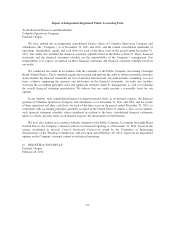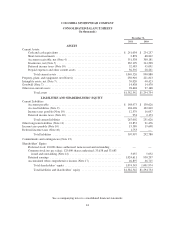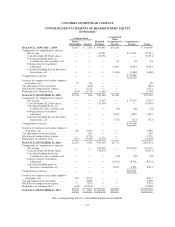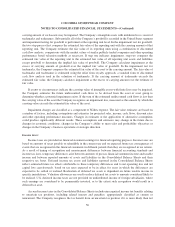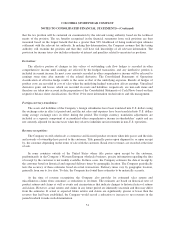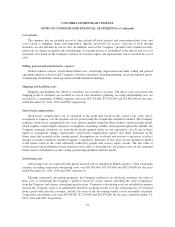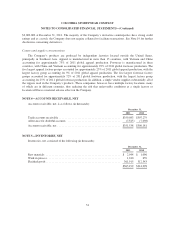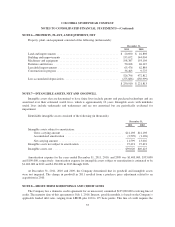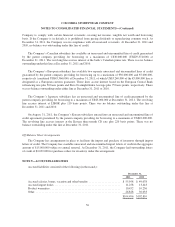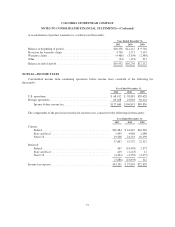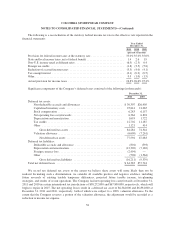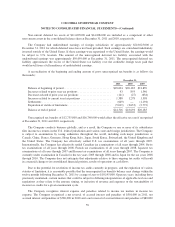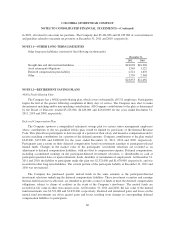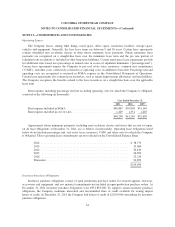Columbia Sportswear 2011 Annual Report Download - page 58
Download and view the complete annual report
Please find page 58 of the 2011 Columbia Sportswear annual report below. You can navigate through the pages in the report by either clicking on the pages listed below, or by using the keyword search tool below to find specific information within the annual report.COLUMBIA SPORTSWEAR COMPANY
NOTES TO CONSOLIDATED FINANCIAL STATEMENTS—(Continued)
Recent Accounting Pronouncements:
In May 2011, the Financial Accounting Standards Board (“FASB”) issued Accounting Standards Update
(“ASU”) No. 2011-04, Fair Value Measurement (Topic 820): Amendments to Achieve Common Fair Value
Measurement and Disclosure Requirements in U.S. GAAP and IFRS. This ASU was issued concurrently with
International Financial Reporting Standards (“IFRS”) 13 Fair Value Measurements, to provide largely identical
guidance about fair value measurement and disclosure requirements. The new standards do not extend the use of
fair value but, rather, provide guidance about how fair value should be applied where it already is required or
permitted under IFRS or U.S. GAAP. This standard is effective prospectively for interim and annual periods
beginning after December 15, 2011. The Company does not expect the adoption of this standard to have a
material effect on the Company’s consolidated financial position, results of operations or cash flows.
In June 2011, the FASB issued ASU No. 2011-05, Comprehensive Income (Topic 220): Presentation of
Comprehensive Income. This ASU increases the prominence of other comprehensive income in financial
statements while eliminating the option in U.S. GAAP to present other comprehensive income in the statement of
changes in equity. Under this ASU, an entity will have the option to present the components of net income and
comprehensive income in either one or two consecutive financial statements. This ASU is effective for fiscal
years, and interim periods within those years, beginning after December 15, 2011. The Company does not expect
the adoption of this standard to have a material effect on the Company’s consolidated financial position, results
of operations or cash flows.
In September 2011, the FASB issued ASU No. 2011-08, Intangibles—Goodwill and Other (Topic 350):
Testing Goodwill for Impairment. This ASU permits an entity to make a qualitative assessment of whether it is
more likely than not that a reporting unit’s fair value is less than its carrying amount before applying the two-step
goodwill impairment test. Under these requirements, an entity would not be required to calculate the fair value of
a reporting unit unless the entity determines, based on the qualitative assessment, that it is more likely than not
that its fair value is less than its carrying amount. The ASU is effective for annual and interim goodwill
impairment tests performed for fiscal years beginning after December 15, 2011. Early adoption is permitted. The
Company does not expect the adoption of this standard to have a material effect on the Company’s consolidated
financial position, results of operations or cash flows.
NOTE 3—CONCENTRATIONS
Trade Receivables
At December 31, 2011, no single customer accounted for 10% or more of consolidated accounts receivable.
At December 31, 2010, the Company had one customer in its Canadian segment that accounted for
approximately 11.9% of consolidated accounts receivable. No single customer accounted for 10% or more of
consolidated revenues for any of the years ended December 31, 2011, 2010 or 2009.
Derivatives
The Company uses derivative instruments primarily to hedge the currency exchange rate risk of anticipated
transactions denominated in non-functional currencies that are designated and qualify as cash flow hedges. The
Company also uses derivative instruments to economically hedge the currency exchange rate risk of certain
investment positions, to hedge balance sheet re-measurement risk and to hedge other anticipated transactions that
do not qualify as cash flow hedges. At December 31, 2011, the Company’s derivative contracts had a remaining
maturity of approximately two years or less. All the counterparties to these transactions had both long-term and
short-term investment grade credit ratings. The maximum net exposure to any single counterparty, which is
generally limited to the aggregate unrealized gain of all contracts with that counterparty, was less than
53


